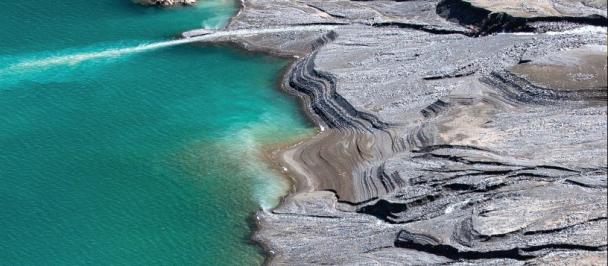Desert monitor. Photo: UNDP Kyrgyzstan
UNDP and the State Committee on Ecology and Climate organized a research expedition to the Western Tian Shan to study the habitat of the red-listed desert monitor.
A desert monitor is one of the largest lizards in Central Asia. Due to the sudden reduction in its population, it was included in the Red List back in 1985. Despite its special conservation status, the desert monitor is still on the verge of extinction. The reptile’s habitat includes Iran, Afghanistan, and the countries of Central Asia.
According to the Red List of the country, in the past the desert monitor was found in Kyrgyzstan in some natural boundaries almost throughout the piedmont area of near Fergana region and going further back – in the Chui and Talas Valleys. However, recently, its habitat has significantly decreased and is limited to the south regions of the country. It was believed for a long time that the desert monitor’s habitat decreased so much that they could be found only in Batken Province.
However, at present, there are facts that some specimens of the red listed desert monitor have been found in Jalal-Abad Province. The UNDP/GEF project has supported a research expedition comprised of the experts from the Department for Biodiversity Conservation and SPNA under the State Committee on Ecology and Climate of the KR and UNDP to Aksy and Nooken districts, Jalal-Abal Province, in order to study in more details and to define the boundaries of the desert monitor’s current habitat in the Western Tian Shan.
Experts set up a camera trap while studying the habitat of the desert monitor. Photo: UNDP Kyrgyzstan
The experts have collected detailed information for further study of the desert monitors using visual monitoring and installing camera traps. According to Azat Osmonov, a chief specialist from the Department for Biodiversity Conservation and SPNA, “the area was more carefully examined, in the places, where the animal was supposed to be found”. “The local residents provided great assistance in detection of the red listed reptiles’ habitat. As a result, in the course of the monitoring, 8 specimens were visually found, but they managed to hide quickly in their holes. However, we could capture them on camera. The total length of the route was about 20-30 km. We mapped the places, where the desert monitors were observed, using a GPS-navigator. Thus, we defined an approximate habitat of the desert monitors in two districts of Jalal-Abad Province”, Azat Osmonov said.
Azat Osmonov, chief specialist of the Department of Biodiversity Conservation and Protected Areas of the State Committee for Ecology and Climate, is holding a meeting with local residents. Photo: UNDP Kyrgyzstan
During the expedition, the expert team met with the residents of the nearby villages and carried out the awareness-building activities telling them about the special status of the endangered endemic and the necessity to preserve this unique species of the fauna in the region.
“According to the local residents, the population of the desert monitor has reduced almost twice over the past 20 years, and this has happened despite the fact that it has been red listed for over 35 years. As a result of the expedition, we have found out that actually the main limiting factor is poaching. The cases of illegal hunting and sale of rare reptiles due to allegedly useful meat and fat are known. Sometimes the local residents have received the orders even from the foreign countries. As the village dwellers say, many people are ready to violate the environmental legislation even being aware of the red list status of the desert monitors and the large penalties for illegal hunting”, - Taalaibek Amanov noted, a field officer of the UNDP/GEF project.
A camera trap captured a desert monitor emerging from its burrow. Photo: UNDP Kyrgyzstan
Pursuant to Resolution No. 224 of the KR Government “On approval of the rates to calculate the amount of the penalties for damages caused to the objects of flora and fauna by legal entities and individuals” dated May 3, 2013, the penalty in the amount of KGS 25 thousand is envisaged for illegal hunting (shooting, capture) of the desert monitor.
The results of the field study indicate that it is reasonable to arrange a faunal reserve since, in addition to the desert monitor, such reptiles as turtles, lizards, Pallas’s cats and marbled polecats have been found on this territory. The latter two species are included in the Red List of the Kyrgyz Republic. The establishment of the faunal reserve would help preserve and further increase the endemic fauna of the Western Tian Shan.
The UNDP and the State Committee for Ecology and Climate are implementing the project on Conservation of globally important biodiversity of the Western Tian Shan. Its main goal is to preserve the unique natural complexes and biodiversity, to contribute to the protection of rare and endangered species of fauna and flora. The project is funded by the Global Environment Facility (GEF). For more details about the project, follow the link.
***
About a desert monitor
According to the Red List of the Kyrgyz Republic, a desert monitor (Varanus griseus (Daudin, 1803) ssp. caspius (Eichwald, 1831) belongs to the scattered populations of the reduced in the number Southern Turan subspecies of the Southern Western-Palearctic species. It is the sole representative of the family in the region. The subspecies is included in CITES Appendix 1, in the Red Lists of the countries of Central Asia.
The length of the large specimens of the desert monitor can reach one and a half meters (90 centimeters out of them is a tail) and the weight is 3-3.5 kg. It uses holes of rodents, birds, turtles as a hiding place, which it expands. It also digs its own holes with the length up to 3 m. It is active in April-October, at a daytime. It eats almost all animals that it can catch (rodents, lizards, birds, turtles, snakes and their eggs, insects, solifugae, etc.), and its toxic saliva helps paralyze a large prey. In 1930-1940-ies, the skin of the desert monitor was used in the industry. This led to the sudden reduction in their number and in some places – to their total disappearance.
***
About the Western Tian Shan
The Western Tian Shan is a mountain system characterized by a high level of endemism and rich flora and fauna. The region is included in the UNESCO World Heritage List and is one of 34 global Biodiversity Hotspots. It is included in the rating of the world ecoregions Global 200 according to the World Wide Fund for Nature (WWF). 27 endangered species of animals inhabit, and 54 species of Red List plants grow on the territory of the Western Tian Shan.
Click here for more photos.

 Locations
Locations

